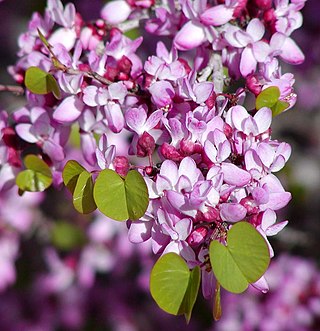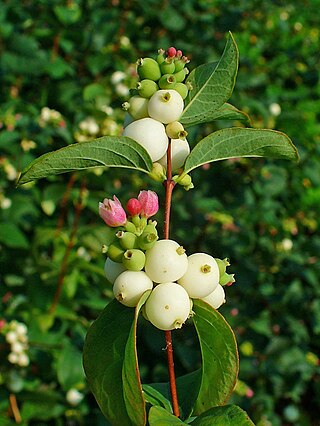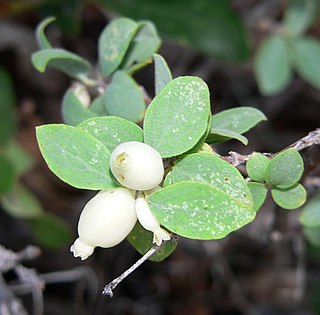
Symphoricarpos is a small genus of about 15 species of deciduous shrubs in the family Caprifoliaceae. With the exception of the Chinese coralberry, S. sinensis, which is indigenous to western China, all species are native to North and Central America. The name of the genus is derived from the Ancient Greek words συμφορεῖν (sumphoreîn), meaning "to bear together", and καρπός (karpós), meaning "fruit". It refers to the closely packed clusters of berries the species produces. Species in the genus are known by several common names, including snowberry, waxberry and ghostberry.
Buckbrush is the common name for several species of North American shrubs that deer feed on, including but probably not limited to:

Cercis occidentalis, the western redbud or California redbud, is a small tree or shrub in the legume family, Fabaceae. It is found primarily in Northern California, with other populations in parts of Utah and Arizona.

Vaccinium ovatum is a North American species of huckleberry in the heather family commonly known as the evergreen huckleberry, winter huckleberry, cynamoka berry and California huckleberry. It has a large distribution on the Pacific Coast of North America ranging from southern British Columbia to southern California. It is a tall woody shrub that produces fleshy, edible berries in the summer. The plant is used for food, natural landscaping, and floral arrangements.

Symphoricarpos mollis, with the common names creeping snowberry, Southern California snowberry, and trip vine, is a shrub in the honeysuckle family.

Symphoricarpos orbiculatus, commonly called coralberry, buckbrush or Indian currant is a woody species of flowering plant in the honeysuckle family.

Symphoricarpos albus is a species of flowering plant in the honeysuckle family known by the common name common snowberry. Native to North America, it is browsed by some animals and planted for ornamental and ecological purposes, but is poisonous to humans.

Symphoricarpos longiflorus is a species of flowering plant in the honeysuckle family known by the common names desert snowberry and fragrant snowberry. It is native to the western United States from the Great Basin to western Texas, as well as northwestern Mexico.

Symphoricarpos rotundifolius is a North American subshrub in the honeysuckle family, also known by the common name round-leaved snowberry.

Physocarpus malvaceus is a species of flowering plant in the rose family known by the common name mallow ninebark. It is native to western North America.

Symphoricarpos oreophilus is a North American species of flowering plant in the Caprifoliaceae, or honeysuckle family, known by the common name mountain snowberry.
Symphoricarpos palmeri, common name Palmer's snowberry, is a North American species of plants in the Honeysuckle Family. It has been found in the southwestern United States, as well as in the Mexican State of Chihuahua inside Basaseachic Falls National Park.
Symphoricarpos hesperius, called the trailing snowberry or creeping snowberry, is a North American species of trailing shrubs in the honeysuckle family. It is native to southwestern Canada and the northwestern United States
Symphoricarpos acutus, the sharpleaf snowberry, is a North American species of trailing shrubs in the honeysuckle family. It is native to the western United States.
Symphoricarpos microphyllus, the pink snowberry, is a North American species of flowering plant in the honeysuckle family. It is widespread across much of Mexico from Chihuahua to Chiapas, and found also in Guatemala, Honduras, and the US State of New Mexico.
Symphoricarpos vaccinioides is a North American species of flowering plant in the honeysuckle family. It had been found in western Canada and in the western United States.
Symphoricarpos parishii, or Parish's snowberry, is a North American species of flowering plant in the honeysuckle family. It had been found in California, Nevada, Arizona, and Baja California.
Symphoricarpos guadalupensis, McKittrock's snowberry, is a rare North American species of plants in the honeysuckle family. It has been found only in South McKittrick Canyon in the Guadalupe Mountains of western Texas. This is inside Guadalupe Mountains National Park.











